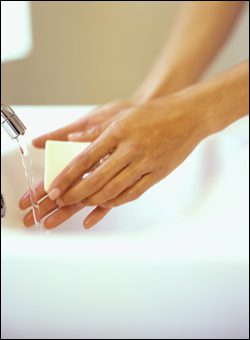

In a recent study, the hands of twenty vaccinated, antibody-positive volunteers were contaminated with 10,000,000 TCID50 of a 1999 seasonal H1N1 influenza virus strain (see this post for an explanation of TCID50). The virus solution was allowed to dry on the hand for 2 minutes. Then one of five different treatments were done:
- Soap and water handwashing
- Use of a gel containing 61.5% ethanol
- Use of a gel containing 70% ethanol and 0.5% chlorhexidine
- Use of a gel containing 70% isopropanol and 0.5% chlorhexidine
- No treatment
The amount of influenza virus on hands before and after treatment was then determined by determining infectivity in cell culture and by measuring viral RNA by polymerase chain reaction (PCR).
There was an immediate reduction in culture-detectable and PCR-detectable virus after the 2 minute drying period. In 14 of 20 individuals, virus was detected by cell culture (average reduction of 1,000€“10,000 TCID50/0.1 mL), and in 6 of 20 no viable H1N1 virus was recovered. These results show that the human hand is a hostile place for influenza virus, possibly because of the combination of drying and natural defenses such as skin oils.
All four hand treatments showed marked antiviral efficacy: 14 of 14 individuals had no virus detected by culture or PCR. Soap and water washing was slightly better than the alcohol-based treatments, but the differences were very slight: 1€“ 100 virus copies/mL. Nevertheless, alcohol-based treatments are likely preferable because they are faster and more portable than washing with soap and water.
This study is not perfect – the number of subjects was small, and the effects of the treatments on different strains of influenza virus was not determined. Nevertheless, the findings that simple washing with soap and water or alcohol-based gels is effective at removing influenza virus from hands is likely to help prevent transmission of infection.
Grayson, M., Melvani, S., Druce, J., Barr, I., Ballard, S., Johnson, P., Mastorakos, T., & Birch, C. (2009). Efficacy of Soap and Water and Alcohol€Based Hand€Rub Preparations against Live H1N1 Influenza Virus on the Hands of Human Volunteers Clinical Infectious Diseases, 48 (3), 285-291 DOI: 10.1086/595845

Comments are closed.